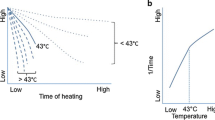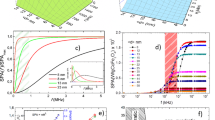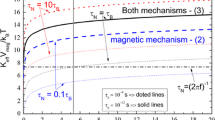Abstract
Our purpose of this study was to present simulation and experimental studies on magnetic hyperthermia (MH) with use of an alternating magnetic field (AMF) and superparamagnetic iron oxide nanoparticles (Resovist®). In the simulation studies, the energy dissipation (P) and temperature rise rate (∆T/∆t) were computed under various conditions by use of the probability density function of the particle size distribution based on a log-normal distribution. P and ∆T/∆t and their dependence on the frequency of the AMF (f) largely depended on the particle size of Resovist®. P and ∆T/∆t reached maximum at a diameter of ~24 nm, and were proportional to the amplitude of the AMF (H 0) raised to a power of ~2.0. In the experimental studies, we made a device for generating an AMF, and measured the temperature rise under various concentrations of Resovist®, H 0, and f. The temperature rise at 10 min after the start of heating was linearly proportional to the concentration of Resovist®, and proportional to H 0 raised to a power of ~2.4, which was slightly greater than that expected from the simulation studies. There was a tendency for the temperature rise to saturate with increasing f. In conclusion, this study will be useful for investigating the feasibility of MH with Resovist® and optimizing the parameters for it.








Similar content being viewed by others
References
Abe M, Hiraoka M, Takahashi M, Egawa S, Matsuda C, Onoyama Y, Morita K, Kakehi M, Sugahara T. Multi-institutional studies on hyperthermia using an 8-MHz radiofrequency capacitive heating device (Thermotron RF-8) in combination with radiation for cancer therapy. Cancer. 1986;58:1589–95.
Oura S, Tamaki T, Hirai I, Yoshimasu T, Ohta F, Nakamura R, Okamura Y. Radiofrequency ablation therapy in patients with breast cancers two centimeters or less in size. Breast Cancer. 2007;14:48–54.
Seip R, Ebbini ES. Noninvasive estimation of tissue temperature response to heating fields using diagnostic ultrasound. IEEE Trans Biomed Eng. 1995;42:828–39.
Gilchrist RK, Medal R, Shorey WD, Hanselman RC, Parrott JC, Taylor CB. Selective inductive heating of lymph nodes. Ann Surg. 1957;146:596–606.
Jordan A, Scholz R, Maier-Hauff K, Johannsen M, Wust P, Nodobny J, Schirra H, Schmidt H, Deger S, Loening S, Lanksch W, Felix R. Presentation of a new magnetic field therapy system for the treatment of human solid tumors with magnetic fluid hyperthermia. J Magn Magn Mater. 2001;225:118–26.
Rosensweig RE. Heating magnetic fluid with alternating magnetic field. J Magn Magn Mater. 2002;252:370–4.
Neuberger T, Schopf B, Hofmann H, Hofmann M, von Rechenberga B. Superparamagnetic nanoparticles for biomedical applications: possibilities and limitations of a new drug delivery system. J Magn Magn Mater. 2005;293:483–96.
Ito A, Shinkai M, Honda H, Kobayashi T. Medical applications of functionalized magnetic nanoparticles. J Biosci Bioeng. 2005;100:1–11.
Balivada S, Rachakatla RS, Wang H, Samarakoon TN, Dani RK, Pyle M, Kroh FO, Walker B, Leaym X, Koper OB, Tamura M, Chikan V, Bossmann SH, Troyer DL. A/C magnetic hyperthermia of melanoma mediated by iron(0)/iron oxide core/shell magnetic nanoparticles: a mouse study. BMC Cancer. 2010;10:119–27.
Shinkai M, Yanase M, Honda H, Wakabayashi T, Yoshida J, Kobayashi T. Intracellular hyperthermia for cancer using magnetite cationic liposome: in vitro study. Jpn J Cancer Res. 1996;87:1179–83.
Le B, Shinkai M, Kitade T, Honda H, Yoshida J, Wakabayashi T, Kobayashi T. Preparation of tumor-specific magnetoliposomes and their application for hyperthermia. J Chem Eng Jpn. 2001;34:66–72.
Shinkai M, Le B, Honda H, Yoshikawa K, Shimizu K, Saga S, Wakabayashi T, Yoshida J, Kobayashi T. Targeting hyperthermia for renal cell carcinoma using human MN antigen-specific magnetoliposomes. Jpn J Cancer Res. 2001;92:1138–45.
DeNardo SJ, DeNardo GL, Miers LA, Natarajan A, Foreman AR, Gruettner C, Adamson GN, Ivkov R. Development of tumor targeting bioprobes (111In-chimeric L6 monoclonal antibody nanoparticles) for alternating magnetic field cancer therapy. Clin Cancer Res. 2005;11:7087s–92s.
Suzuki M, Shinkai M, Kamihira M, Kobayashi T. Preparation and characteristics of magnetite-labelled antibody with the use of poly (ethylene glycol) derivatives. Biotechnol Appl Biochem. 1995;21:335–45.
Moroz P, Jones SK, Winter J, Gray BN. Targeting liver tumors with hyperthermia: ferromagnetic embolization in a rabbit liver tumor model. J Surg Oncol. 2001;78:22–9.
Takamatsu S, Matsui O, Gabata T, Kobayashi S, Okuda M, Ougi T, Ikehata Y, Nagano I, Nagae H. Selective induction hyperthermia following transcatheter arterial embolization with a mixture of nano-sized magnetic particles (ferucarbotran) and embolic materials: feasibility study in rabbits. Radiat Med. 2008;26:179–87.
Maenosono S, Saita S. Theoretical assessment of FePt nanoparticles as heating elements for magnetic hyperthermia. IEEE Trans Magn. 2006;42:1638–42.
Kiss LB, Soderlund J, Niklasson GA, Granqvist CG. New approach to the origin of lognormal size distributions of nanoparticles. Nanotechnology. 1999;10:25–8.
Biederer S, Knopp T, Sattel TF, Ludtke-Buzug K, Gleich B, Weizenecker J, Borgert J, Buzug TM. Magnetization response spectroscopy of superparamagnetic nanoparticles for magnetic particle imaging. J Phys D: Appl Phys. 2009;42:205007.
Press WH, Teukolsky SA, Vetterling WT, Flannery BP. Numerical recipes in C. Oxford: Cambridge University Press; 1992.
Kallumadil M, Tada M, Nakagawa T, Abe M, Southern P, Pankhurst QA. Suitability of commercial colloids for magnetic hyperthermia. J Magn Magn Mater. 2009;321:1509–13.
Lawaczeck R, Bauer H, Frenzel M, Hasegawa M, Ito Y, Kito K, Miwa N, Tsutsui H, Vogler H, Weinmann HJ. Magnetic iron oxide particles coated with carboxydextran for parenteral administration and liver contrasting: pre-clinical profile of SH U555A. Acta Radiol. 1997;38:584–97.
Jordan A, Scholz R, Wust P, Fahling H, Krause J, Wlodarczyk W, Sander B, Vogl T, Felix R. Effects of magnetic fluid hyperthermia (MFH) on C3H mammary carcinoma in vivo. Int J Hyperth. 1997;13:587–605.
Deng Z-S, Liu J. Analytical study on bioheat transfer problems with spatial or transient heating on skin surface or inside biological bodies. J Biomech Eng. 2002;124:638–49.
Bagaria HG, Johnson DT. Transient solution to the bioheat equation and optimization for magnetic fluid hyperthermia treatment. Int J Hyperth. 2005;21:57–75.
Pennes HH. Analysis of tissue and arterial blood temperatures in the resting human forearm. J Appl Physiol. 1948;1:93–122.
Shih TC, Kou HS, Liauh CT, Lin WL. The impact of thermal wave characteristics on thermal dose distribution during thermal therapy: a numerical study. Med Phys. 2005;32:3029–36.
Horng TL, Lin WL, Liauh CT, Shih TC. Effects of pulsatile blood flow in large vessels on thermal dose distribution during thermal therapy. Med Phys. 2007;34:1312–20.
Acknowledgment
The authors thank the editors and reviewers who spent a great deal of time and gave us informative advice for improving our manuscript.
Author information
Authors and Affiliations
Corresponding author
About this article
Cite this article
Murase, K., Oonoki, J., Takata, H. et al. Simulation and experimental studies on magnetic hyperthermia with use of superparamagnetic iron oxide nanoparticles. Radiol Phys Technol 4, 194–202 (2011). https://doi.org/10.1007/s12194-011-0123-4
Received:
Revised:
Accepted:
Published:
Issue Date:
DOI: https://doi.org/10.1007/s12194-011-0123-4




